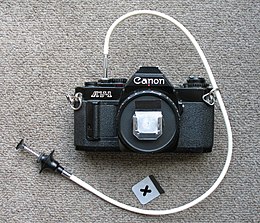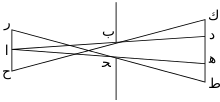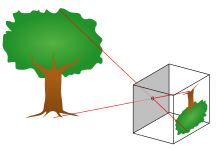Can You Enlarge The Hole On A Pinhole Camera?

A habitation-made pinhole photographic camera lens
A pinhole camera is a uncomplicated camera without a lens but with a tiny aperture (the so-called pinhole)—effectively a calorie-free-proof box with a small hole in one side. Light from a scene passes through the aperture and projects an inverted image on the opposite side of the box, which is known equally the photographic camera obscura upshot. The size of the images depends on the distance between the object and the pinhole.
History [edit]
Camera obscura [edit]
The camera obscura or pinhole image is a natural optical miracle. Early on known descriptions are institute in the Chinese Mozi writings (circa 500 BCE)[one] and the Aristotelian Issues (circa 300 BCE – 600 CE).[2]

A diagram depicting Ibn al-Haytham's observations of lite'south behaviour through a pinhole

Early pinhole camera. Light enters a dark box through a modest hole and creates an inverted image on the wall opposite the pigsty.[iii]
Ibn al-Haytham (965–1039), an Arab physicist as well known as Alhazen, described the camera obscura effect. Over the centuries others started to experiment with it, mainly in dark rooms with a small opening in shutters, more often than not to report the nature of light and to safely spotter solar eclipses.[4]
Giambattista Della Porta wrote in 1558 in his Magia Naturalis about using a concave mirror to projection the image onto paper and to utilise this equally a drawing aid.[5] However, at about the same fourth dimension, the utilise of a lens instead of a pinhole was introduced. In the 17th century, the camera obscura with a lens became a popular drawing help that was farther developed into a mobile device, offset in a little tent and afterward in a box. The photographic camera, every bit developed early in the 19th century, was basically an adaptation of the box-type camera obscura with a lens.
The term "pin-hole" in the context of optics was establish in James Ferguson'due south 1764 book Lectures on select subjects in mechanics, hydrostatics, pneumatics, and optics.[6] [7]
Early pinhole photography [edit]
The first known description of pinhole photography is establish in the 1856 book The Stereoscope by Scottish inventor David Brewster, including the clarification of the thought as "a camera without lenses, and with only a pin-hole".
Sir William Crookes and William de Wiveleslie Abney were other early photographers to endeavor the pinhole technique.[8]
Film and integral photography experiments [edit]
Co-ordinate to inventor William Kennedy Dickson, the first experiments directed at moving pictures past Thomas Edison and his researchers took place around 1887 and involved "microscopic pivot-point photographs, placed on a cylindrical trounce". The size of the cylinder corresponded with their phonograph cylinder as they wanted to combine the moving images with sound recordings. Problems arose in recording clear pictures "with phenomenal speed" and the "coarseness" of the photographic emulsion when the pictures were enlarged. The microscopic pin-point photographs were soon abandoned.[9] In 1893 the Kinetoscope was finally introduced with moving pictures on celluloid moving-picture show strips. The camera that recorded the images, dubbed Kinetograph, was fitted with a lens.
Eugène Estanave experimented with integral photography, exhibiting a result in 1925 and publishing his findings in La Nature. After 1930 he chose to proceed his experiments with pinholes replacing the lenticular screen.[ten]
Usage [edit]
The image of a pinhole photographic camera may exist projected onto a translucent screen for a real-fourth dimension viewing (used for condom observation of solar eclipses) or to trace the image on newspaper. But it is more often used without a translucent screen for pinhole photography with photographic movie or photographic paper placed on the surface reverse to the pinhole aperture.
A mutual apply of pinhole photography is to capture the motion of the sun over a long menstruum of fourth dimension. This blazon of photography is called solarigraphy. Pinhole photography is used for artistic reasons, simply too for educational purposes to let pupils larn about, and experiment with, the nuts of photography.
Pinhole cameras with CCDs (charge-coupled devices) are sometimes used for surveillance because they are difficult to observe.
Related cameras, image forming devices, or developments from information technology include Franke'south widefield pinhole camera, the pinspeck camera, and the pinhead mirror.
Mod manufacturing has enabled the product of high quality pinhole lenses[11] that can be applied to digital cameras; allowing photographers and videographers to achieve the photographic camera obscura upshot.
Characteristics of pinhole camera photography [edit]
- As pinhole photographs have nearly infinite depth of field, everything appears in focus.
- Equally in that location's no lens distortion, wide-bending images remain absolutely rectilinear.
- Exposure times are usually long, resulting in motion blur around moving objects and the absence of objects that moved too fast.
Other special features tin can be built into pinhole cameras such as the ability to take double images by using multiple pinholes, or the ability to take pictures in cylindrical or spherical perspective by curving the film aeroplane.
Construction [edit]

A home-made pinhole photographic camera (on the left), wrapped in blackness plastic to prevent low-cal leaks, and related developing supplies
Pinhole cameras can be handmade by the photographer for a particular purpose. In its simplest form, the photographic pinhole camera can consist of a lite-tight box with a pinhole in ane end, and a slice of moving-picture show or photographic paper wedged or taped into the other end. A flap of paper-thin with a tape hinge can be used equally a shutter. The pinhole may exist punched or drilled using a sewing needle or pocket-size diameter bit through a piece of tinfoil or thin aluminum or contumely sail. This piece is then taped to the inside of the light-tight box behind a hole cut through the box. A cylindrical oatmeal container may be made into a pinhole camera.
The interior of an effective pinhole camera is black to avoid any reflection of the inbound light onto the photographic material or viewing screen.[12]
Pinhole cameras can be constructed with a sliding film holder or back and then the altitude between the picture show and the pinhole can be adjusted. This allows the angle of view of the camera to be changed and besides the constructive f-end ratio of the camera. Moving the film closer to the pinhole will result in a wide angle field of view and shorter exposure time. Moving the film farther away from the pinhole will result in a telephoto or narrow-angle view and longer exposure time.
Pinhole cameras can also be constructed by replacing the lens associates in a conventional camera with a pinhole. In item, compact 35 mm cameras whose lens and focusing assembly have been damaged can exist reused equally pinhole cameras—maintaining the use of the shutter and film winding mechanisms. As a effect of the enormous increase in f-number, while maintaining the aforementioned exposure fourth dimension, i must use a fast film in direct sunshine.
Pinholes (homemade or commercial) tin be used in place of the lens on an SLR. Employ with a digital SLR allows metering and composition by trial and error, and is effectively free, and so is a popular way to try pinhole photography.[13]
Pick of pinhole size [edit]
Up to a certain betoken, the smaller the hole, the sharper the image, but the dimmer the projected image. Optimally, the size of the aperture should be 1/100 or less of the distance betwixt it and the projected image.
Within limits, a small pinhole through a thin surface will result in a sharper image resolution considering the projected circumvolve of defoliation at the image plane is practically the same size as the pinhole. An extremely modest hole, however, tin can produce significant diffraction effects and a less clear image due to the moving ridge properties of low-cal.[14] Additionally, vignetting occurs as the diameter of the hole approaches the thickness of the material in which information technology is punched, because the sides of the hole obstruct the light entering at anything other than ninety degrees.
The all-time pinhole is perfectly round (since irregularities cause higher-social club diffraction furnishings) and in an extremely thin slice of material. Industrially produced pinholes do good from laser carving, but a hobbyist can still produce pinholes of sufficiently high quality for photographic work.
A method of calculating the optimal pinhole bore was first published by Joseph Petzval in 1857. The smallest possible diameter of the image point and therefore the highest possible paradigm resolution and the sharpest image are given when:[15]
(Where d is the pinhole diameter, f is the distance from pinhole to prototype plane or "focal length" and λ is the wavelength of lite.)
The first to apply wave theory to the problem was Lord Rayleigh in 1891. But due to some wrong and arbitrary deductions he arrived at:[16]
So his optimal pinhole was approximatively i/3 bigger than Petzval's.
The right optimum can be found with Fraunhofer approximation of the diffraction blueprint backside a circular aperture at:
This may be shortened to: (When d and f in Millimeters and λ = 550 nm = 0.00055 mm, respective to xanthous-green.)
For a pinhole-to-film altitude of 1 inch or 25.4 mm, this works out to a pinhole of 0.185 mm (185 microns) in bore. For f= 50 mm the optimal diameter is 0.259 mm.
The depth of field is basically infinite, but this does not mean that no optical blurring occurs. The infinite depth of field means that image mistiness depends not on object distance merely on other factors, such as the distance from the discontinuity to the film plane, the aperture size, the wavelength(s) of the light source, and motion of the discipline or canvas. Additionally, pinhole photography tin can not avoid the effects of haze.

An example of a 20-minute exposure taken with a pinhole camera

A photograph taken with a pinhole camera using an exposure time of 2s

A graph of the resolution limit of the pinhole camera as a office of focal length (prototype distance).
In the 1970s, Immature measured the resolution limit of the pinhole photographic camera every bit a function of pinhole diameter[17] and later published a tutorial in The Physics Teacher.[18] Partly to enable a diverseness of diameters and focal lengths, he defined two normalized variables: pinhole radius divided by resolution limit, and focal length divided by the quantity due south 2/λ, where s is the radius of the pinhole and λ is the wavelength of the low-cal, typically near 550 nm. His results are plotted in the figure.
On the left-side of the graph, the pinhole is big, and geometric eyes applies; the resolution limit is near one.five times the radius of the pinhole. (Spurious resolution is also seen in the geometric-eyes limit.) On the right-side, the pinhole is pocket-size, and Fraunhofer diffraction applies; the resolution limit is given by the far-field diffraction formula shown in the graph and now increases every bit the pinhole is made smaller. In the region of near-field diffraction (or Fresnel diffraction), the pinhole focuses the lite slightly, and the resolution limit is minimized when the focal length f (the distance between the pinhole and the pic plane) is given past f = due south two/λ. At this focal length, the pinhole focuses the calorie-free slightly, and the resolution limit is about two/3 of the radius of the pinhole. The pinhole, in this case, is equivalent to a Fresnel zone plate with a single zone. The value s 2/λ is in a sense the natural focal length of the pinhole.
The relation f = s 2/λ yields an optimum pinhole diameter d = 2√ fλ , so the experimental value differs slightly from the estimate of Petzval, in a higher place.
Calculating the f-number and required exposure [edit]

A fire hydrant photographed past a pinhole camera made from a shoe box, exposed on photographic paper to create the negative image (pinnacle). The positive image (bottom) was created digitally from the negative image. The length of the exposure was xl seconds. At that place is noticeable flaring in the lesser-correct corner of the image, likely due to extraneous light entering the camera box.
The f-number of the camera may be calculated past dividing the distance from the pinhole to the imaging plane (the focal length) past the diameter of the pinhole. For example, a camera with a 0.5 mm diameter pinhole, and a 50 mm focal length would have an f-number of fifty/0.five, or 100 (f/100 in conventional notation).
Due to the large f-number of a pinhole camera, exposures volition often encounter reciprocity failure.[19] Once exposure time has exceeded about one second for motion picture or 30 seconds for paper, one must compensate for the breakdown in linear response of the film/newspaper to intensity of illumination by using longer exposures.
Exposures projected on to modernistic light-sensitive photographic flick tin can typically range from v seconds upwardly to as much as several hours, with smaller pinholes requiring longer exposures to produce the same size image. Because a pinhole photographic camera requires a lengthy exposure, its shutter may be manually operated, as with a flap made of opaque material to embrace and uncover the pinhole.
Coded apertures [edit]
A not-focusing coded-aperture optical system may be idea of as multiple pinhole cameras in conjunction. By adding pinholes, light throughput and thus sensitivity are increased. Nevertheless, multiple images are formed, usually requiring computer deconvolution.
Mod day interest in pinhole photography [edit]
A revival in popularity has become evident in recent years with the success of Kickstarter crowdfunding campaigns offering a range of pinhole photography products. From a photographic camera crafted from forest[20] to the Pinhole Pro[11] - a sleek lens designed for DSLR and MILC digital cameras - these projects take fatigued investment from thousands of enthusiastic backers to raise hundreds of thousands of dollars.
Natural pinhole phenomenon [edit]

A pinhole camera effect can sometimes occur naturally. Small "pinholes" formed by the gaps between overlapping tree leaves will create replica images of the sun on flat surfaces. During an eclipse, this produces small crescents in the instance of a fractional eclipse, or hollow rings in the case of an annular eclipse.
Observation [edit]
Worldwide Pinhole Photography Mean solar day is observed on the concluding Sunday of April, every year.[21]
Photographers using the technique [edit]
- Billy Childish
- George Davison
- Barbara Ess
- Wolf Howard
- Steven Pippin
- Jesse Richards
Run across also [edit]
- Photographic camera obscura (usually employs a lens)
- Dirkon
- Henry Fox Talbot
- Ibn al-Haytham
- Nautilus (whose pinhole heart functions every bit a camera obscura)
- Pinhole photographic camera model
- Pinhole glasses
- Pinhole occluder, a like device used by ophthalmologists
- Spatial filter
- The Not bad Motion picture
- Zone plate
References [edit]
- ^ "CS194-26: proj2". inst.eecs.berkeley.edu . Retrieved 2022-01-07 .
- ^ "Camera Obscura: Ancestor of Modern Photography | Encyclopedia.com". www.encyclopedia.com . Retrieved 2022-01-07 .
- ^ Kirkpatrick, Larry D.; Francis, Gregory E. (2007). "Light". Physics: A World View (half dozen ed.). Belmont, California: Thomson Brooks/Cole. p. 339. ISBN978-0-495-01088-iii.
- ^ Plott, John C. (1984). Global History of Philosophy: The Period of scholasticism (part one). p. 460. ISBN978-0-89581-678-8.
- ^ Zik, Yaakov; Hon, Giora (10 February 2019). "Claudius Ptolemy and Giambattista Della Porta: Two Contrasting Conceptions of Optics". arXiv:1902.03627 [physics.hist-ph].
- ^ "Nick's pinhole photography". thought.uwosh.edu . Retrieved 29 January 2018.
- ^ Ferguson, James (1764). Lectures on select subjects in mechanics, hydrostatics, pneumatics, and eyes with the employ of the globes, the art of dialing, and the adding of the mean times of new and full moone and eclipses.
- ^ "Pinhole photography history". photo.internet. Archived from the original on 2017-02-02. Retrieved 29 January 2018.
- ^ History of the kinetograph, kinetoscope, & kinetophonograph [by] Due west. Grand. L. Dickson and Antonia Dickson. Literature of movie theater. Arno Printing. 1970. hdl:2027/mdp.39015002595158. ISBN9780405016110.
- ^ Timby, Kim (31 July 2015). 3D and Animated Lenticular Photography. ISBN9783110448061.
- ^ a b "Pinhole Pro Lens by Thingyfy". 2018.
- ^ "How to Make and Use a Pinhole Camera". Archived from the original on 2016-03-05.
- ^ "V3 - digital transformation news, analysis and insight". v3.co.uk . Retrieved 18 October 2018.
- ^ Hecht, Eugene (1998). "5.7.vi The Camera". Optics (tertiary ed.). ISBN0-201-30425-2.
- ^ Petzval, Joseph Maximilian (1857), "Bericht über dioptrische Untersuchungen". Vortrag vom 23. Juli 1857; in: Sitzungsberichte der kaiserlichen Akademie der Wissenschaften, mathematisch-naturwissenschaftliche Classe, vol. XXVI, S. 33-90
- ^ Lord Rayleigh Sec. R.S. (1891), Ten."On Pin-hole Photography", in: Philosophical Mag, Series v, Volume 31, 1891 – Issue 189, pp.87-99
- ^ Young, K. (1971). "Pinhole optics". Applied Optics. 10 (12): 2763–2767. Bibcode:1971ApOpt..10.2763Y. doi:10.1364/ao.10.002763. PMID 20111427.
- ^ Young, Matt (1989). "The pinhole photographic camera: Imaging without lenses or mirrors". The Physics Teacher. 27 (9): 648–655. Bibcode:1989PhTea..27..648Y. doi:10.1119/ane.2342908.
- ^ breslin, nancy a. "Nancy Breslin's pinhole photographic camera exposure tips". www.nancybreslin.com . Retrieved 29 January 2018.
- ^ "Wooden pinhole photographic camera past ONDU". 2015.
- ^ "Worldwide Pinhole Photography Day". pinholeday.org.
Further reading [edit]
- Eric Renner Pinhole Photography: From Historic Technique to Digital Awarding [ ISBN missing ]
External links [edit]
![]() Media related to Pinhole cameras at Wikimedia Commons
Media related to Pinhole cameras at Wikimedia Commons
- pinhole.cz
- Pinhole Photography by Vladimir Zivkovic
- Worldwide Pinhole Photography Day website
- An piece of cake way to convert a DSLR to a pinhole camera
- Pinhole Photography and Camera Design Calculators
- Illustrated history of cinematography
- Oregon Art Beat: Pinhole Photos by Zeb Andrews
- Civil War 150 Pinhole Projection by Michael Falco
Source: https://en.wikipedia.org/wiki/Pinhole_camera
Posted by: carterawye2001.blogspot.com






0 Response to "Can You Enlarge The Hole On A Pinhole Camera?"
Post a Comment